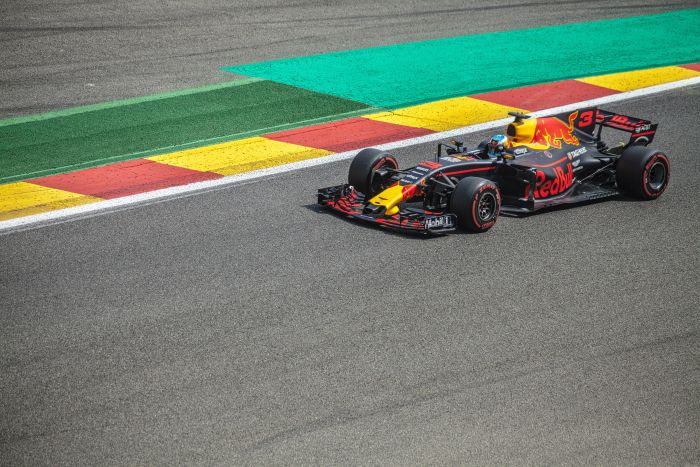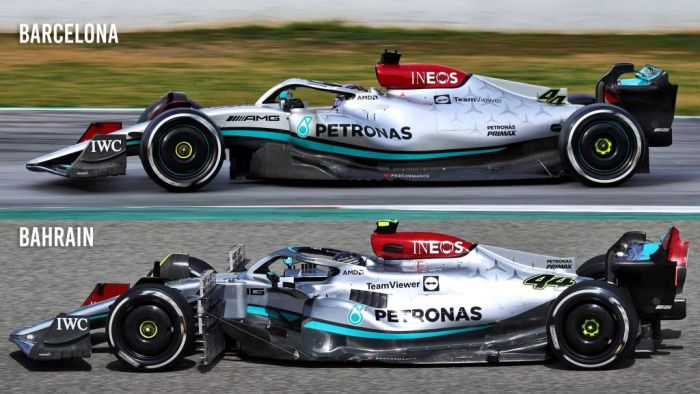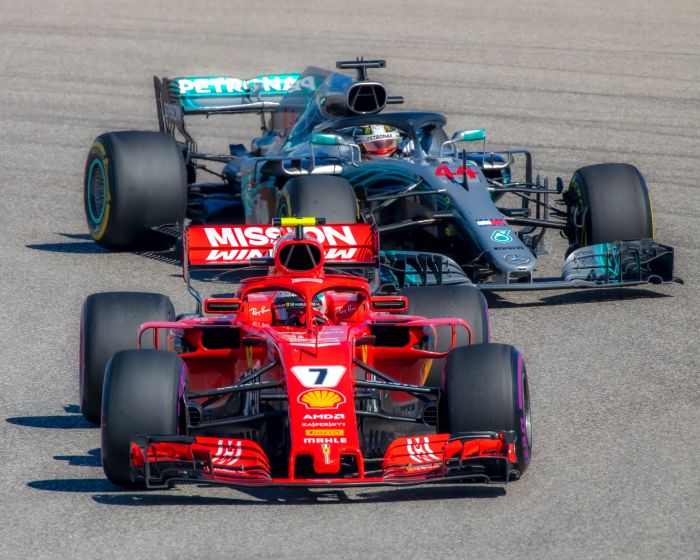
Formula 1 cars have evolved into a wide variety of configurations and dimensions over the course of the sport’s history. F1 cars must always abide by the constantly evolving FIA regulations, which specify what size the car has to be for any given season. As a result, F1 cars have gotten larger over the years.
So, why are F1 cars getting bigger? F1 cars are getting bigger over the years because there are a lot of modifications made to the chassis and overall design. These changes are made to give the best performance on the world’s greatest circuits and race tracks.
Over time, Formula 1 cars have grown significantly larger and thicker. There is a significant change between a modern Formula 1 car and a vintage one manufactured in the late 1980s or earlier. In addition to being heavier than earlier models, new vehicles are also greater in size.
Despite the fact that current Formula 1 vehicles are far larger than they always were, the latest model is paradoxically becoming shorter.
Both the racing and the way the vehicles are driven are significantly influenced by the dimensions of the vehicle. In order to know why F1 cars have grown larger, let’s take a deeper look.
Table of Contents
What Size Are F1 Cars?

On average, F1 cars measure 5.5 meters in length and 2 meters in width. The FIA’s regulations heavily influence the dimensions of an F1 car.
They establish specifications that need to be followed in order to specify the general shape and dimension of the cars. The team will receive a penalty if a car surpasses the specified parameters.
If you want to know Why Do F1 Cars Have Sidepods? (INTERESTING FACTS!!!), click here.
Formula 1 vehicles look considerably shorter than they really are thanks to their streamlined and aerodynamic shape. Comparing Formula 1 and World Endurance Championship prototype cars is a good way to show how many people this illusion may deceive.
Note: WEC prototypes are generally much smaller than Formula 1 vehicles, but because of their “bulkier” shape, they appear to be much bigger.
A Misperception Of Size
A Formula 1 car may appear significantly smaller since it is lower to the ground and vertically shorter than the typical road car. They may, however, be broader and longer than the typical Audi A4 in both length and breadth. Once more, it is an appearance brought about by the cars’ aerodynamic designs.
Formula 1 cars are limited to heights of 95 cm and widths of 200 cm. Teams may construct their automobiles in accordance with these guidelines.
If you want to know What Are F1 Grid Penalties? (DETAILED EXPLANATION), click here.
The car’s length, however, is not directly capped. To better comprehend how long an F1 car really is, let’s focus on how dimension restrictions on other components indirectly limit the length of an F1 car.
How Long Are F1 Cars?

The length of an F1 automobile is roughly 5.5 meters. But Formula 1 vehicles weren’t always this big. Formula 1 vehicles started off significantly shorter and have gotten longer over time.
The regulations for the length of a Formula 1 car have become less stringent than those for width and height.
If you want to know How Much Does an F1 Pit Crew Member Earn? (INTERESTING FACTS), click here.
When analyzing the vehicles entered by various Formula 1 teams, it is clear that the teams have more leeway in terms of the total length of the cars, which is something that is readily apparent.
In spite of this, there is a safety regulation that must be adhered to regarding the overall length of a Formula 1 car. The vehicle’s front end is required to meet a minimum length requirement to safeguard the driver in the event of a frontal collision.
Note: Additionally, dimension constraints on several other parts ensure that there is an indirect limit placed on the total length of the vehicle.
Since frontal collisions are so frequent in Formula 1, having a larger nose shields the driver’s legs from injury. The pedals are located directly behind the front nose cone, and the driver’s legs extend well forward into the cockpit.
If you want to know What Is the Top Speed of an F1 Car? (AMAZING!!!), click here.
How Wide Did F1 Cars Become?

The Formula One cars have increasingly gotten broader in addition to getting longer as the years have progressed.
On the other hand, if you compare a new Formula 1 car with an older one, you can clearly perceive a significant distinction comparing the two.
If you want to know How Long Is a Formula One Season? (For The Fans), click here.
There is a discernible difference in the breadth and overall size of the automobile, even dating back to the middle of the 2000s when the cars were attacked for being “extremely huge.”
The Formula 1 cars’ allowable width was increased by the FIA to 2 meters in 2017, making them the largest they’ve ever been. Wider vehicles generated greater drag, which led to lower straight-line speeds and faster cornering speeds.
Size Changes in F1 Cars
As we have seen in the past, regulations are what cause automobiles to evolve; hence, we can observe a progression in the weight and size of cars throughout time as they have been both larger and heavier as a result of this development.
To track the growth of car size, we’ve included a few example vehicles from each decade in the following table:
| Decade | Car | Weight | Length |
|---|---|---|---|
| 2010s | Red Bull RB9 (2013) Mercedes WO8 (2017) | 642 kg 722 kg | 5,080 mm 5,700 mm |
| 2000s | Renault R2 | 600 kg | 4,800 mm |
| 1990s | Ferrari F310 | 600 kg | 4,355 mm |
| 1980s | McLaren MP4/2 | 540 kg | 4,343 mm |
| 1970s | Lotus 72 | 600 kg | 4,191 mm |
| 1960s | Porsche 804 | 455 kg | 3,600 mm |
| 1950s | Alfa Romeo 158/159 Alfetta | 630 kg (710 kg in the 2nd version) | 4,293 mm |
Why Did Formula 1 Cars Become So Big?
Security and safety is the key driver behind Formula 1 vehicles’ increased size. Formula 1 is a very risky sport, and many safety precautions including parts like survival cells and fuel tanks have resulted in substantially larger cars.
This has been demonstrated numerous times by numerous drivers suffering injuries in the previous era, and the sport also had a greater fatality percentage in the old days when vehicles were considerably shorter and the driver was significantly exposed.
If you want to know What Are The Best F1 Simulators? (ON THE MARKET), click here.
The FIA adopted some fundamental regulations to increase the size of automobiles in order to make them safer.
The teams are compelled to use stronger parts and include bigger crumple zones as a result. This implies that there is a lower likelihood of a driver suffering injuries in a serious collision.
Were There Any Rule Modifications in F1?

There have been some rule changes in F1 and as a result of regulation modifications, Formula 1 vehicles have simultaneously grown in size.
Refueling prohibition implemented at the beginning of the 2010 season was the first rule modification that had an impact on the size of the vehicles. Refueling was prohibited because it endangered the safety of the drivers and pit crew.
If you want to know How Many F1 Drivers Have Died? (CHRONOLOGICAL), click here.
There were a few cases in which a pit stop was completed too quickly, causing a car to leave the pits while a fuel hose was still linked to the vehicle.
Heikki Kovalainen, a McLaren driver, quickly exited his pit box during the 2009 Brazilian Grand Prix, which caused him to pull the gasoline hose from the fuel distribution system.
While he was hauling the fuel hose along the pit lane, a small amount of fuel spilled onto Kimi Raikkonen’s Ferrari in the back of him, causing a flash fire that briefly lit the Ferrari on fire.
Fortunately, Raikkonen was able to avoid serious injuries; nonetheless, the fuel and fumes that spilled onto his car left him with stinging eyes.
Another one is when Felipe Massa exited his pit box at the 2008 Singapore Grand Prix while the gasoline pipe was still attached, dragging numerous crew workers into the path of approaching Formula 1 vehicles. Fortunately, no one was seriously hurt during this occurrence.
If you want to know How Much Does a NASCAR Car Cost? (IN DETAIL), click here.
Why Did the FIA Banned Refueling?
The accidents that happened to Felipe Massa and Heikki Kovalainen led to the decision, which in the end resulted that, the FIA came to the conclusion that refueling should not be allowed in the sport at all, and they gave the teams the instruction that they needed to construct vehicles that were capable of driving the entire race distance without having to add any additional gasoline to the vehicle at pit stops.
As a result, Formula 1 vehicles needed to be bigger than earlier models in order to fit a larger fuel tank. The end effect was a nearly threefold increase in gasoline tank capacity from 20 to 55 gallons.
If you want to know What is Formula 1 DRS? (THINGS YOU DIDN’T KNOW), click here.
This gave several teams a lot of trouble. The majority of teams had a difficult time getting their vehicles to finish the full race distance without making some kind of fuel-saving maneuver at some point throughout the competition.
This is because auto racing is a sport in which it is essential to cut as much weight as you can to achieve the highest level of performance.
Note: The fuel tank on modern Formula 1 vehicles is 30 gallons. This demonstrates how far technology has come and how significantly effective engines are today. The contemporary Formula 1 engine is so effective that it can cover the same distance using just approximately half as much fuel as it did in the past.
Why Are F1 Cars Still so Big?

If this is the case, then why are F1 vehicles still so massive yet the gas tanks are only half as big compared to 10 years ago?
Today’s Formula 1 vehicles have accumulated so much superfluous heft due to the development of so many aerodynamic components. The complexity of hybrid engines also increased, introducing more components that require more room.
If you want to know What’s the Difference Between IndyCar and F1? (YOU DIDN’T KNOW), click here.
What Effect Do Weight And Size Have On An F1 Car’s Handling?
An F1 car’s size and weight alter how you drive it, especially when negotiating curves.
When driving lighter and smaller cars in the past, the fastest move was to brake later and attack the corner’s apex forcefully. This gave the impression that the drivers were exceeding their capabilities.
The fastest course of action is frequently just around the bend, though. It is more important to exit the turn quickly than necessarily take the apex.
Fix the car as soon as you can. This indicates that despite possessing the fastest cars in the history of transportation, there is no sensation of driving at the limit when viewed from the outside.
Note: Additionally, the number of cars increases over time but the length of the queues stays the same. On urban tracks such as Monaco, where it is generally tough to pass with existing cars, it is practically impossible to do. At the same time, passing is far more challenging than before on other iconic circuits like Imola.
Which F1 Car Is Bigger: 2022 or 2021?
The Formula 1 vehicles for 2022 are smaller in size compared to the 2021 models. The revised aerodynamic regulations are primarily responsible for this development.
Less aerodynamic winglets and bargeboards will be used in cars starting in 2022 because they are made to generate cleaner air in their trail. The length of the autos has also been slightly reduced.
Instead of adding additional bodywork, teams are now urged to create downforce utilizing the car’s floor. Because of this, the cars shouldn’t get too big and complicated as they have in prior seasons.
To make their vehicles faster, many teams will always push the envelope and look for ways to get outside the rules, as is the case with every Formula 1 season.
Should F1 cars be more compact?
The Formula 1 cars have reportedly gotten too huge, according to several drivers and fans. It is impossible for fans to gauge the scale of the automobile without seeing it compared to earlier iterations of the car or looking at it on a Television screen, even if there are many people who could disagree with this statement.
After seeing his 2017 championship contender for the first time, Lewis Hamilton remarked that it looked “like a boat,” referring to the FIA’s decision to expand the highest possible width of Formula 1 vehicles to 2 meters in 2017.
It is obvious that the driver believes the automobiles are too huge because he has driven in the 2000s, 2010s, and 2020s.
It’s a well-known fact that smaller cars are considerably simpler to drive and control, which translates to a more exciting competition.
The smaller the automobiles, the more room there is for them to navigate around one another, which in turn makes it possible for there to be more possibilities to pass. In the case of tight courses like street circuits, this is extremely significant.
F1 cars: Were They Faster Before?
The F1 vehicles in 2020 and 2021 were the fastest ever. The aerodynamic downforce of today’s Formula One cars is largely responsible for their incredible acceleration. Faster lap times are obtained as a result of the cars being able to turn at considerably faster speeds without losing traction.
The years 2020 and 2021 saw the production of the Formula 1 vehicles that were the fastest ever produced. These vehicles broke numerous previously held track records, some of which dated back to the Schumacher era of the early 2000s.
Note: Lewis Hamilton established the record for the fastest lap ever in qualifying for the Formula One race at Monza in 2020, driving at an average speed of 164 miles per hour. This record is one example of how fast the vehicles will be in the year 2020.
What Are the Specifications of 2022 F1 Cars?
The weight of F1 cars in 2022 is the highest it has ever been. This is partly due to the fact that the 18–inch rims, which were introduced in 2022, are heavier than the 13–inch rims now in use. Additionally, a number of safety-related modifications, primarily to the chassis, resulted in the 2022 cars being heavier than before.
It’s not always the case that heavier cars are slower, though. Kimi Räikkönen’s previous record from 2018 was surpassed by Lewis Hamilton’s pole-position lap at Monza in 2020 by an average speed of 1 mph.
On the other hand, he was driving an automobile that was approximately 12 kg significantly heavier than the one Kimi was driving, demonstrating that weight isn’t everything, especially not when it comes to variances that are pretty minor.
Conclusion
The size of Formula 1 cars has increased significantly over time. The size of Formula 1 cars has increased as a result of the need to conform to numerous regulatory changes throughout the generations, with the gas tank dimensions and other safety elements being the most significant modifications.
